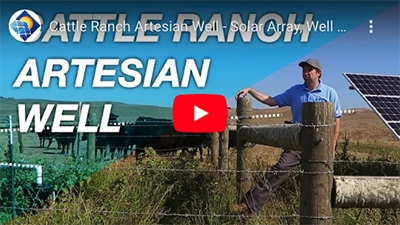Sizing for a Well Cap or Seal
Link Mentioned at 5:34, How to Measure Your Well Casing — https://www.rpssolarpumps.com/measuring-well-casing-size-for-your-solar-pump-well-cap-seal/ Your well is valuable, and keeping it covered with the right equipment protects your investment. Today, Mike reviews the differences between well caps and seals, and how to measure circumference and diameter for each. For more on well seals and casings: https://www.rpssolarpumps.com/learn/well-head-plumbing-well-caps-vs-well-seals/ To learn more about wells, solar pumping and off grid systems visit our education center: https://www.rpssolarpumps.com/learn/ To shop solar pumps: https://shop.rpssolarpumps.com/
this is mike with rps solar pumps i’m going to give you a quick overview of weld caps well seals and a little bit about weld casings first of all if you have a well you’re either going to have a pvc or a steel well casing the weld casing goes down into the ground and it prevents dirt and other debris from coming into the well and filling it up now the majority of the time if you’re in softer soils the well casing is going to go all the way down to the bottom down at the bottom of the well they have slotted casings and that allows the water to flow in through the gravel pack and it helps provide a filter and keep other sand and debris out of your well if you’re in a place with bedrock they’re going to bring the weld casing down to the bedrock and when they drill through the bedrock they’re not going to case that because the rock itself acts as the casing and prevents anything from falling in a majority of weld casings are going to be pvc these days a lot of older wells use metal casings but a majority of the time they switch to pvc due to its corrosion resistance because it’s not going to rust over time we can see here a piece of well casing and it has a flared end this allows for easy joining of the casing as they’re loading it in because we can glue here and join the two pieces together without any external couplers if you have this flared end up on a newly drilled well you’re probably going to want to cut it off if the weld driller didn’t do so already because well caps and well seals are sized for the standard inside and outside diameter dimensions of your weld casing not this flared portion we look over here it’s a very standard well where we have our pvc casing coming off and it’s been cut off clean that makes a nice easy surface to work with the two most common are well cap these go over the outside of the pipe or a well seal the well seal i’ll show you in a second it slides down a little bit into the well casing and it reacts the load and holds all of the drop pipe in place well seals are usually used in warmer environments where we don’t expect hard freezes if you’re using a pit less adapter that’s going to connect down below the ground and instead we’re going to use a well cap a well cap’s going to go over the top of the casing and it has an opening here to allow the electrical wires to go up and down into your well these are used in areas where it’s common for freezing you’re going to need to bear your drop pipe down below the surface using a pitless adapter so you’re not going to freeze all your piping and you’re going to be able to pump water during the winter in order to figure out what size of either well cap or well seal we need we need to measure either the inside diameter or the outside diameter of the weld casing it’s as simple as taking a tape measure and if we’re measuring for a well seal we want the inside diameter so we’re going to place the end of the tape measure on the inside and measure to the inside of the opposite side in this case we have a four inch casing and that’s a four inch measurement that is going to correspond to the well sealed size we want this is called a four inch well seal the inside is four inch the outside is around four and a half a little bit larger so it covers the whole top of the casing this is super simple to install they simply slip onto our well casing and all the other pipes are going to go through here both our drop pipe and our electrical conduit
if you’re using a weld cap you can measure the inside diameter but you could also measure the outside diameter here again we can measure the outside diameter and that is four and a half inches so in that case we want a four inch weld cap might also be called a four and a half inch wall cap depending on exactly who you’re purchasing from this instead slips over the outside of the pipe and there’s screws to tighten it down and then our electrical cables using a conduit can run up in and down to our pump if you’re out on the middle of the field and you don’t have a tape measure readily available see if you can find a piece of string with a piece of string we can wrap it around the outside of the
casing we can cut it to length
then we can bring this little section home in our truck and we’re back in the shop we can take out our tape measure measure the length of the string
this case it’s right around
14 and a half inches and then we want to divide that 14 and a half by 3.14 that’s going to give us the outside diameter of our weld casing and for this one it’s going to give us four and a half inches this is a super simple basic measurement we measure the inside diameter and then buy the appropriate well cap or well seal well casing diameter varies both regionally and based on the type of well it is for residential wells very common sizes are four five and six inch casings when you go to either older wells or agricultural wells they tended to use larger casings hate up to 10 or 12 or even bigger diameters depending on the volume of water needed to pump we have all this information on our website both with inside diameter and outside diameter measurements so you can take the measurements and check which one fits the closest to your well casing in order to get the proper well seal or well-capped size for your well casing if you’re looking for a solar pump give us a call at rps solar pumps at 888-637-4493 or visit us at rpssolarpumps.com we don’t need this information for your initial pump sizing but if you’re going to get a weld cap or well sealed from us we’re going to need that information to make sure you get the right size
Are you looking for a solar pump?
RPS is a family-owned company of laser-focused mechanical, electrical and software engineers that live and breathe solar pumping almost every hour of every day. We have sales offices in a number of states now, but our main shop has moved to an Ag town in California (we do get poked fun of for this!) and our warehouse to move there shortly. We put great time, money and thought into our kits – including parts and components to make installation a breeze. Our reading materials, manuals, videos and diagrams allow customers of all skill levels to install a solar pump successfully the first time. As has become famous, we also offer a direct line to talk with real humans! ..our actual pump engineers for asking questions, helping troubleshoot, or planning for installation.


